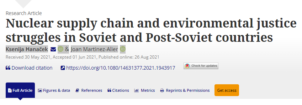
By Ksenija Hanaček & Joan Martinez-Alier
ABSTRACT
This article addresses and contributes to the discussion on nuclear supply chain socio-environmental conflicts in Soviet and post-Soviet contexts by bringing it together with nuclear peripheralization and environmental justice approaches. Descriptive statistics and qualitative coding were applied to 14 cases identified in the Global Atlas of Environmental Justice. Visible protests were first detected in 1976. The cases analysed comprise the whole nuclear supply chain; uranium mining bans, stopping nuclear reactors, and nuclear testing bans. Seven of the conflictive projects have been suspended by neighbours, citizens and communities, women, industrial workers, and Indigenous groups. However, nuclear projects remain of ongoing concern related to nuclear waste and potential nuclear accidents. Military violence intrinsic to nuclear power domination encounters anti-nuclear resistance in areas where nuclear socio-environmental legacies and current injustices are lived.
KEYWORDS: Environmental Conflicts | Nuclear Supply Chain | Peripheralization | Environmental Justice | EJAtlas
Full article available here at Taylor and Francis Online for registered users and purchase.

The project ENVJUSTICE has received funding from the European Research Council (ERC) under the European Union’s Horizon 2020 research and innovation programme (grant agreement No. 695446)